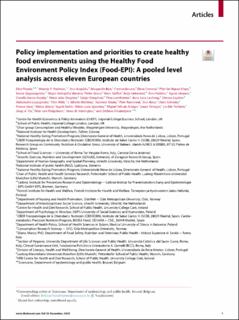| dc.contributor.author | Pineda, Elisa | |
| dc.contributor.author | Poelman, Maartje | |
| dc.contributor.author | Aaspõllu, Anu | |
| dc.contributor.author | Bica, Margarida | |
| dc.contributor.author | Bouzas, Cristina | |
| dc.contributor.author | Carrano, Elena | |
| dc.contributor.author | De Miguel-Etayo, Pilar | |
| dc.contributor.author | Djojosoeparto, Sanne | |
| dc.contributor.author | Gabrijelčič Blenkuš, Mojca | |
| dc.contributor.author | Graca, Pedro | |
| dc.contributor.author | Geffert, Karin | |
| dc.contributor.author | Hebestreit, Antje | |
| dc.contributor.author | Helldán, Anni | |
| dc.contributor.author | Henjum, Sigrun | |
| dc.contributor.author | Huseby, Camilla Sanne | |
| dc.contributor.author | Gregorio, Maria Joao | |
| dc.contributor.author | Kamphuis, Carlijn B.M. | |
| dc.contributor.author | Laatikainen, Tiina | |
| dc.contributor.author | Løvhaug, Anne Lene | |
| dc.contributor.author | Leydon, Clarissa | |
| dc.contributor.author | Luszczynska, Aleksandra | |
| dc.contributor.author | Mäki, Päivi | |
| dc.contributor.author | Martinez, J. Alfredo | |
| dc.contributor.author | Raulio, Susanna | |
| dc.contributor.author | Romaniuk, Piotr | |
| dc.contributor.author | Roos, Gun | |
| dc.contributor.author | Salvador, Clara | |
| dc.contributor.author | Sassi, Franco | |
| dc.contributor.author | Silano, Marco | |
| dc.contributor.author | Sotlar, Ingrid | |
| dc.contributor.author | Specchia, Maria Lucia | |
| dc.contributor.author | de Arriaga, Miguel Telo | |
| dc.contributor.author | Terragni, Laura | |
| dc.contributor.author | Torheim, Liv Elin | |
| dc.contributor.author | Tur, Joseph A. | |
| dc.contributor.author | von Philipsborn, Peter | |
| dc.contributor.author | Harrington, Janas M. | |
| dc.contributor.author | Vandevijvere, Stefanie | |
| dc.coverage.spatial | Europe | en_US |
| dc.date.accessioned | 2022-12-19T15:11:53Z | |
| dc.date.available | 2022-12-19T15:11:53Z | |
| dc.date.created | 2022-11-16T09:47:10Z | |
| dc.date.issued | 2022-11-16 | |
| dc.identifier.citation | The Lancet Regional Health - Europe. 2022, 23 (100522), . | en_US |
| dc.identifier.issn | 2666-7762 | |
| dc.identifier.uri | https://hdl.handle.net/11250/3038674 | |
| dc.description.abstract | Background: Food environments have been recognised as highly influential on population diets. Government policies have great potential to create healthy food environments to promote healthy diets. This study aimed to evaluate food environment policy implementation in European countries and identify priority actions for governments to create healthy food environments.
Methods: The Healthy Food Environment Policy Index (Food-EPI) was used to evaluate the level of food environment policy and infrastructure support implementation in Estonia, Finland, Germany, Ireland, Italy, the Netherlands, Norway, Poland, Portugal, Slovenia, and Spain in 2019−2021. Evidence of implementation of food environment policies was compiled in each country and validated by government officials. National experts evaluated the implementation of policies and identified priority recommendations.
Findings: Finland had the highest proportion (32%, n = 7/22) of policies shaping food environments with a “high” level of implementation. Slovenia and Poland had the highest proportion of policies rated at very low implementation (42%, n = 10/24 and 36%, n = 9/25 respectively). Policies regarding food provision, promotion, retail, funding, monitoring, and health in all policies were identified as the most important gaps across the European countries. Experts recommended immediate action on setting standards for nutrients of concern in processed foods, improvement of school food environments, fruit and vegetable subsidies, unhealthy food and beverage taxation, and restrictions on unhealthy food marketing to children.
Interpretation: Immediate implementation of policies and infrastructure support that prioritize action towards healthy food environments is urgently required to tackle the burden of obesity and diet-related non-communicable diseases in Europe. | en_US |
| dc.description.sponsorship | This project has received funding from the European Union’s Horizon 2020 research and innovation programme under grant agreement No 774548 and from the Joint Programming Initiative “A Healthy Diet for a Healthy Life”. | en_US |
| dc.language.iso | eng | en_US |
| dc.publisher | Elsevier | en_US |
| dc.relation.ispartofseries | The Lancet Regional Health - Europe;Volume 23, December 2022, 100522 | |
| dc.rights | Attribution-NonCommercial-NoDerivatives 4.0 Internasjonal | * |
| dc.rights.uri | http://creativecommons.org/licenses/by-nc-nd/4.0/deed.no | * |
| dc.subject | Food environments | en_US |
| dc.subject | Obesity | en_US |
| dc.subject | Non-communicable diseases | en_US |
| dc.subject | Public health policies | en_US |
| dc.subject | Healthy food environment policy index | en_US |
| dc.subject | Food-EPI | en_US |
| dc.title | Policy implementation and priorities to create healthy food environments using the Healthy Food Environment Policy Index (Food-EPI): A pooled level analysis across eleven European countries | en_US |
| dc.type | Peer reviewed | en_US |
| dc.type | Journal article | en_US |
| dc.description.version | publishedVersion | en_US |
| dc.rights.holder | © 2022 The Author(s) | en_US |
| dc.source.articlenumber | 100522 | en_US |
| cristin.ispublished | true | |
| cristin.fulltext | original | |
| cristin.qualitycode | 1 | |
| dc.identifier.doi | https://doi.org/10.1016/j.lanepe.2022.100522 | |
| dc.identifier.cristin | 2074626 | |
| dc.source.journal | The Lancet Regional Health - Europe | en_US |
| dc.source.volume | 23 | en_US |
| dc.source.issue | 23 | en_US |
| dc.source.pagenumber | 1-24 | en_US |
| dc.relation.project | Horisont 2020: EC/H2020/774548 | en_US |

